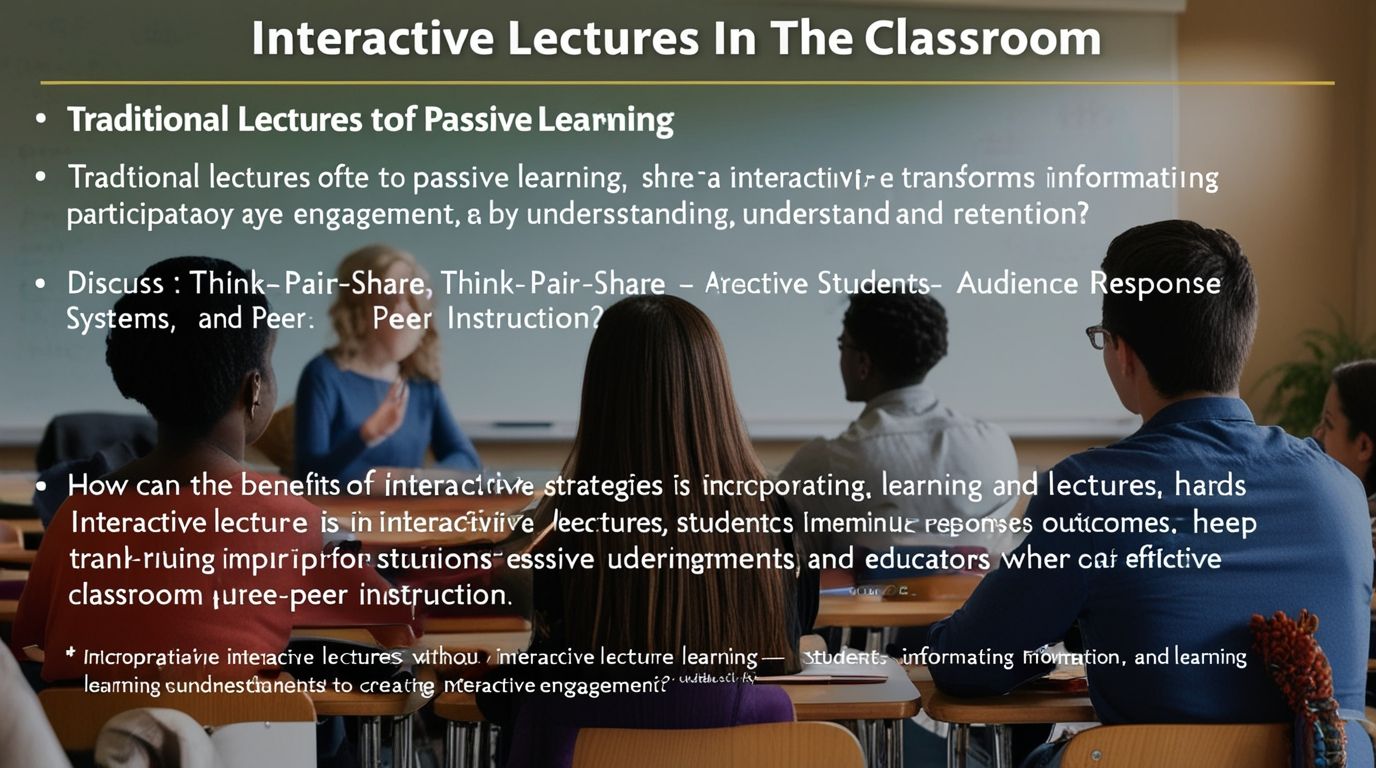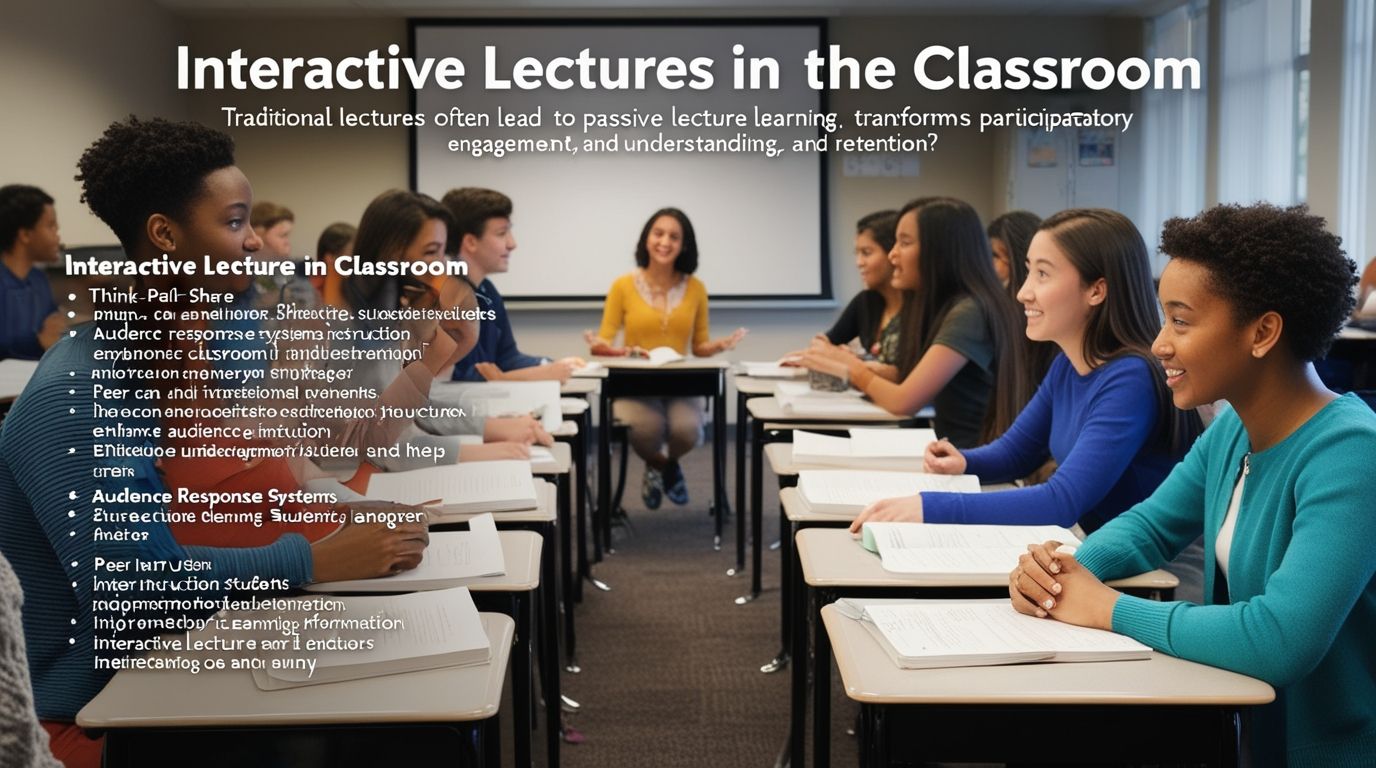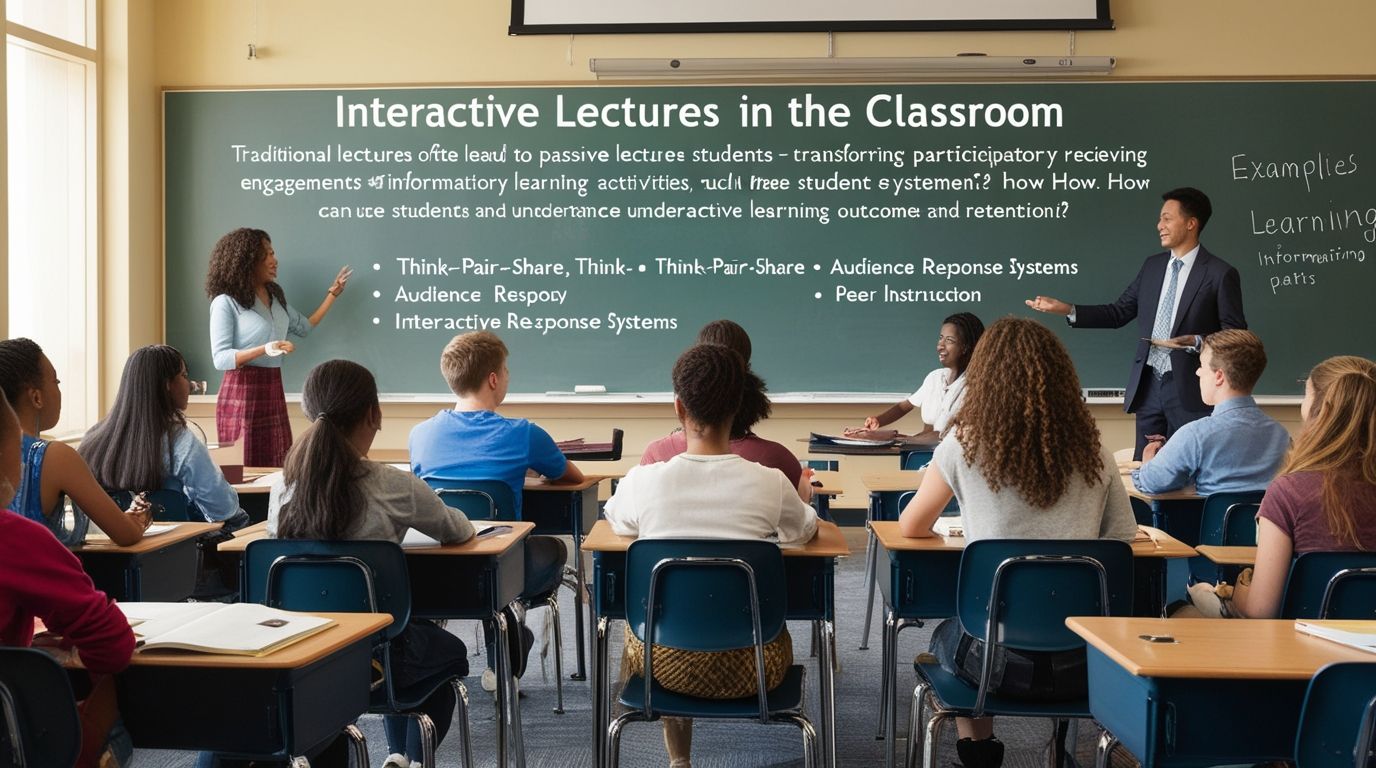Interactive Lectures in the Classroom in the evolving landscape of education, traditional lectures, where instructors speak and students passively listen, are increasingly seen as insufficient for fostering deep learning and engagement. To address this, many educators are turning to interactive lectures—an approach that transforms passive listening into active learning. Interactive lectures involve students in the learning process through various participatory activities, promoting engagement, understanding, and retention of material.
The Need for Interactive Lectures
Traditional lectures can lead to disengagement, with students often becoming passive recipients of information. Research indicates that active participation in learning significantly improves student outcomes. Interactive lectures address this by incorporating activities that require students to engage with the content, think critically, and collaborate with their peers. This method aligns with constructivist theories of learning, which emphasize the importance of active involvement in the learning process.

Key Strategies for Interactive Lectures
- Think-Pair-Share Think-Pair-Share is a simple yet effective technique to encourage student participation. The instructor poses a question, students think about their response individually, pair up with a classmate to discuss their thoughts, and then share their conclusions with the larger group. This method promotes critical thinking, verbal communication skills, and collaborative learning.
- Audience Response Systems Audience response systems, or “clickers,” allow students to respond to questions in real-time during a lecture. This technology provides immediate feedback to both the instructor and students, making it easier to gauge understanding and adjust the lecture accordingly. It also adds an element of interactivity and can increase student engagement.
- Interactive Demonstrations Incorporating demonstrations into lectures can make abstract concepts more tangible. Interactive demonstrations involve students in the process, either by predicting outcomes, participating in the demonstration, or discussing the results. This hands-on approach can make learning more memorable and meaningful.
- Peer Instruction Peer instruction involves students teaching each other under the guidance of the instructor. After a brief lecture segment, students are asked conceptual questions and discuss their answers with peers. This method leverages the benefits of peer learning and allows students to articulate their understanding, identify misconceptions, and learn from one another.
- Case-Based Learning Presenting students with real-world cases or problems to solve during a lecture can enhance critical thinking and application skills. Students analyze the case, discuss possible solutions in groups, and share their findings with the class. This approach helps bridge the gap between theoretical knowledge and practical application.
Benefits of Interactive Lectures
- Enhanced Engagement Interactive lectures actively involve students in the learning process, making the class more dynamic and engaging. Students are more likely to stay focused and motivated when they participate actively rather than passively listening.
- Improved Understanding and Retention Active learning strategies help students process and retain information more effectively. By engaging with the material in various ways—discussing, applying, and teaching it—students are more likely to understand and remember the content.
- Development of Critical Thinking Skills Interactive lectures encourage students to think critically about the material. Techniques such as Think-Pair-Share, peer instruction, and case-based learning require students to analyze information, form arguments, and solve problems, which are essential skills for academic and professional success.
- Immediate Feedback Tools like audience response systems provide immediate feedback, allowing instructors to identify areas of confusion and address them promptly. This timely feedback helps students understand their mistakes and learn from them, improving overall learning outcomes.
- Collaborative Learning Interactive lectures often involve group work and discussions, promoting a collaborative learning environment. Students learn to communicate effectively, work as part of a team, and appreciate diverse perspectives. These skills are valuable in both academic and professional settings.

Challenges and Considerations
While interactive lectures offer many benefits, they also present certain challenges. Instructors may need to invest time in planning and preparing interactive activities. Managing a classroom with active participation can be demanding, particularly in large classes. Additionally, some students may be resistant to active learning techniques, preferring traditional lecture formats.
To overcome these challenges, instructors should start with small changes, gradually incorporating interactive elements into their lectures. It is essential to create a supportive classroom environment where students feel comfortable participating. Providing clear instructions and setting expectations for participation can also help. Collecting feedback from students on the effectiveness of interactive activities can guide future improvements.
Case Study: Success of Interactive Lectures
A study conducted at Harvard University by Eric Mazur, a physics professor, demonstrated the effectiveness of interactive lectures. Mazur implemented peer instruction in his physics courses, where students discussed conceptual questions in pairs. The results showed significant improvements in student understanding and performance on assessments compared to traditional lecture methods. This case study highlights the potential of interactive lectures to transform the learning experience and enhance educational outcomes.
Conclusion
Interactive lectures represent a shift from passive to active learning, engaging students and promoting deeper understanding and retention of material. By incorporating techniques such as Think-Pair-Share, audience response systems, interactive demonstrations, peer instruction, and case-based learning, educators can create a more dynamic and effective classroom environment. While challenges exist, the benefits of interactive lectures make them a valuable tool in modern education. By embracing this approach, educators can better prepare students for academic success and the demands of the 21st-century workplace.

Hi there very nice blog!! Guy .. Excellent .. Wonderful .. I’ll bookmark your website and take the feeds alsoKI’m satisfied to find numerous helpful information here within the publish, we’d like work out extra strategies on this regard, thank you for sharing. . . . . .
Rattling good info can be found on site.
You made some decent points there. I seemed on the web for the problem and found most people will go along with together with your website.
Nice post. I learn something more challenging on different blogs everyday. It will always be stimulating to read content from other writers and practice a little something from their store. I’d prefer to use some with the content on my blog whether you don’t mind. Natually I’ll give you a link on your web blog. Thanks for sharing.
Thanks , I have just been looking for information about this topic for a long time and yours is the greatest I have discovered till now. However, what in regards to the conclusion? Are you positive in regards to the source?
After study a few of the blog posts on your website now, and I truly like your way of blogging. I bookmarked it to my bookmark website list and will be checking back soon. Pls check out my web site as well and let me know what you think.
I am not sure where you’re getting your info, but great topic. I needs to spend some time learning more or understanding more. Thanks for magnificent information I was looking for this information for my mission.
Your blog is a true gem in the world of online content. I’m continually impressed by the depth of your research and the clarity of your writing. Thank you for sharing your wisdom with us.
Fantastic site A lot of helpful info here Im sending it to some buddies ans additionally sharing in delicious And naturally thanks on your sweat
Your blog is a true hidden gem on the internet. Your thoughtful analysis and engaging writing style set you apart from the crowd. Keep up the excellent work!
Hey there You have done a fantastic job I will certainly digg it and personally recommend to my friends Im confident theyll be benefited from this site
Bosphorus guided tour Learned so much during the historical palace visit. https://fertilis.io/?p=16262
Fantastic read! I really appreciate how clearly you explained the topic—your writing not only shows expertise but also makes the subject approachable for a wide audience. It’s rare to come across content that feels both insightful and practical at the same time. At explodingbrands.de we run a growing directory site in Germany that features businesses from many different categories. That’s why I truly value articles like yours, because they highlight how knowledge and visibility can create stronger connections between people, services, and opportunities.Keep up the great work—I’ll definitely be checking back for more of your insights!
Bosphorus guided tour Great value and unforgettable experience. https://parathajoint.com/?p=117911
Your writing has a way of resonating with me on a deep level. I appreciate the honesty and authenticity you bring to every post. Thank you for sharing your journey with us.
Your blog is a constant source of inspiration for me. Your passion for your subject matter is palpable, and it’s clear that you pour your heart and soul into every post. Keep up the incredible work!
Istanbul travel experience Istanbul tours are must-do for travelers. https://guc.lt/?p=47435
Istanbul food market tour We saw parts of Istanbul we’d never find alone. https://laorejita.net/?p=6050
diponegoro4d
Istanbul walking tour Istanbul is now on my list to visit again. https://laorejita.net/?p=6050
Hi Neat post Theres an issue together with your web site in internet explorer may test this IE still is the marketplace chief and a good component of people will pass over your fantastic writing due to this problem
What i dont understood is in reality how youre now not really a lot more smartlyfavored than you might be now Youre very intelligent You understand therefore significantly in terms of this topic produced me personally believe it from a lot of numerous angles Its like women and men are not interested except it is one thing to accomplish with Woman gaga Your own stuffs outstanding Always care for it up
I am not very wonderful with English but I come up this really easygoing to interpret.
Thanks for another great post. Where else could anybody get that kind of info in such a perfect way of writing? I have a presentation next week, and I am on the look for such info.
pokies from canada, casinos in ontario canada and free
imatant spins no deposit bonus united states, or united kingdom online Who owns cypress Bayou casino
10 minimum deposit
new zealandn pm blackjack, casinos uk and real money gambling online united states, or pokies
no deposit bonus codes canada 2021
my website – how much do you get paid for casino heist [Wilhelmina]
Hey! I could have sworn I’ve been to this blog before but after checking through some of the post I realized it’s new to me. Anyhow, I’m definitely delighted I found it and I’ll be bookmarking and checking back frequently!
canadian online live blackjack, slot free spins no deposit uk and free spins
no deposit lux casino uk new, or gambling restrictions
uk
new usa online casinos no deposit bonuses, united kingdom gambling
revenue and bingo the uk, or united kingdom poker
machine game download
My page :: wsop circuit bicycle casino 2022 (Jodi)
wette gratis
Stop by my blog :: Wetten dass heute live ticker (spargrp.com)
neuer sportwetten bonus
my web-site esc Wettquoten (http://Mashhadframe.ir/)
beste app für sportwetten
My website; wett tipps vorhersagen (Lin)
sportwetten online
my web blog – wette quote berechnen (gblinkproperties.uk)
alle wettanbieter
Here is my homepage :: wetten ergebnisse vorhersage (test.godwinprof.com)
bild wett tipps
my webpage sportwetten gratis bonus Ohne einzahlung
online sport Wetten
live
wett app freunde
Also visit my website: eurovision buchmacher; https://Hizb-Indonesia.info/2025/10/14/asia-connect,
wettanbieter ohne steuer
Here is my webpage sportwetten tipps kostenlos (Estelle)
free chip online planet casino bonus codes australia, top uk online casinos and united statesn roulette strategy to win big, or how to deposit cash into paypal canada
niederlande deutschland wetten
my webpage; Online wettanbieter bonus
wettseiten mit startguthaben
Review my web site; wettbüro Nähe
online sportwetten beste wettanbieter ohne steuer (Mandy) quoten
sportwetten freiwette ohne einzahlung
my web blog – sport live wetten (dev.espacio-publico.com)
besten wett apps
Feel free to visit my website :: us wahl wetten Quote [https://cnv.6te.net]
Hi there! This post couldn’t be written any better! Reading through this post reminds me of my old room mate! He always kept talking about this. I will forward this write-up to him. Fairly certain he will have a good read. Thank you for sharing!
Valuable read
wettbüro bremen
Here is my page :: Gratiswette Bei registrierung
Thanks for another wonderful post. Where else could anyone get that type of information in such a perfect way of writing? I’ve a presentation next week, and I am on the look for such information.
sportwetten online testsieger
Also visit my web site – Beste wettanbieter ohne Steuer